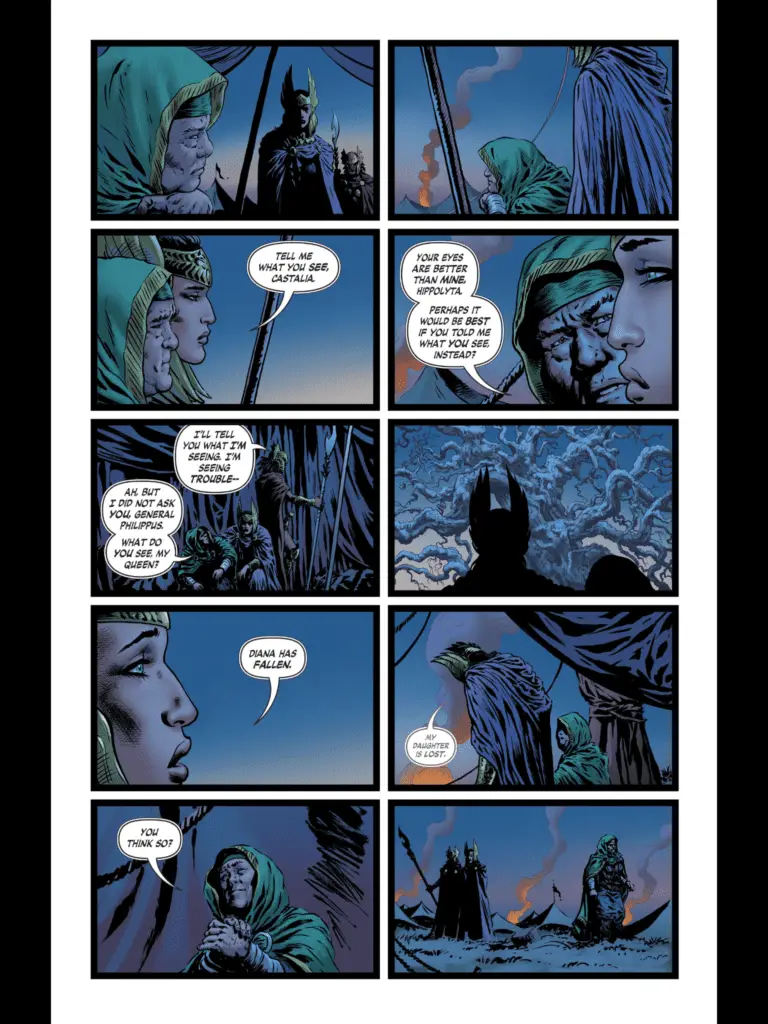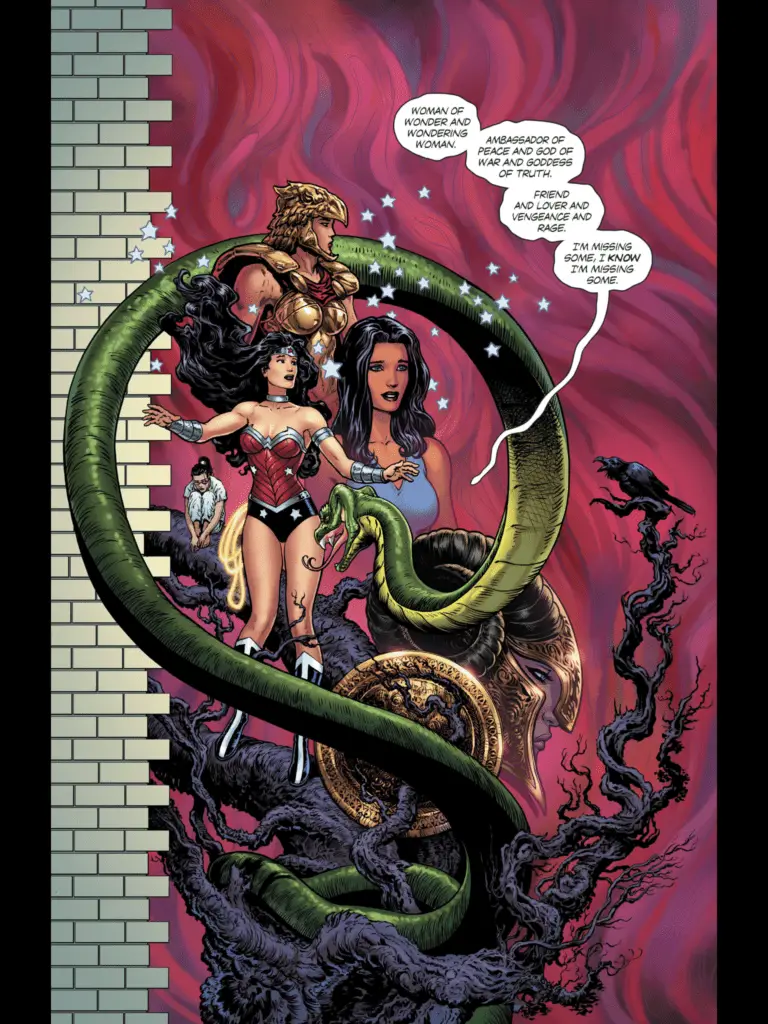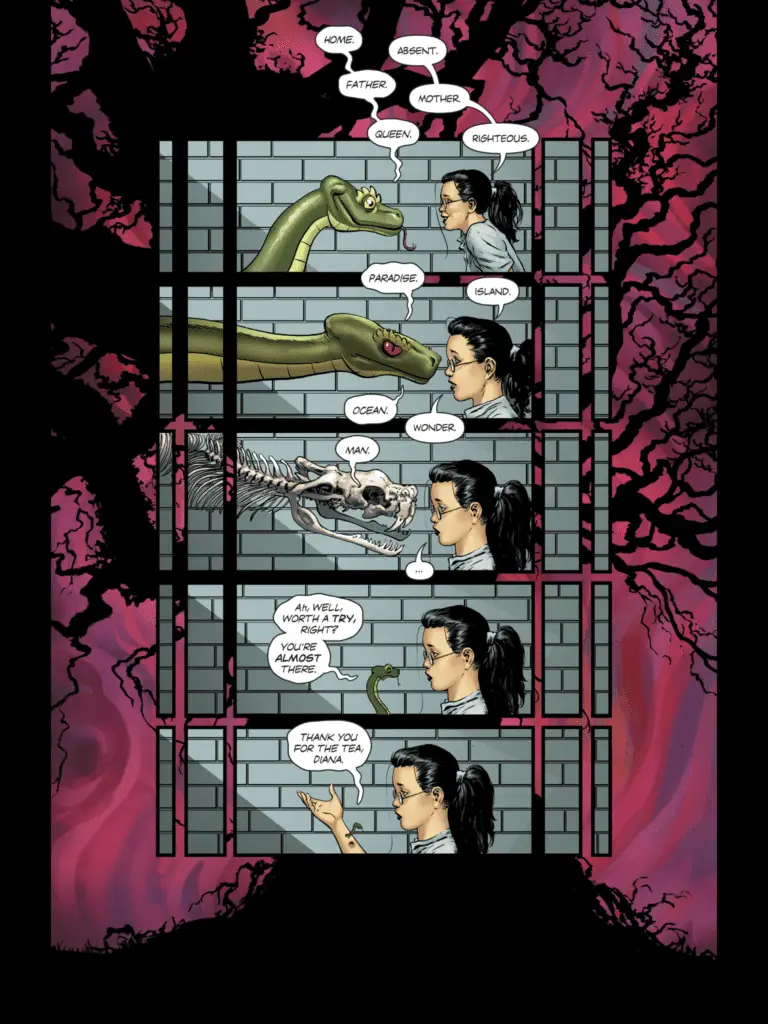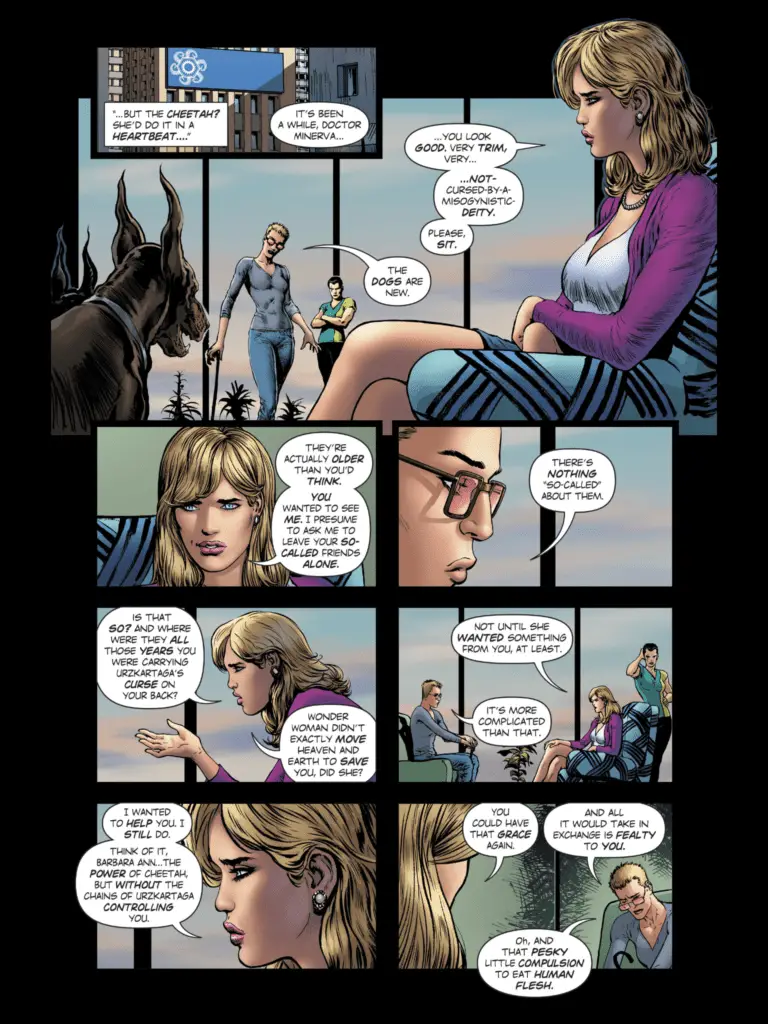So far, Wonder Woman‘s “The Truth” arc has dropped the ball in a rather fundamental way: It has not been about Wonder Woman. The past few issues have cast Steve Trevor in the role of The Hero, and that character shift stems from more than just having him be competent in fighting off the bad guys. The story focus has been on Steve, on how he is experiencing the action and how he is feeling, with Wonder Woman cast as icon and damsel for him to rescue and focus on and be motivated by. Even if the arc had no other problems with its story progression and portrayal of mental health issues, the fact that the Wonder Woman series was no longer about Wonder Woman would have been a knock against it. Now, however, even though Steve is still in the middle of the gunfights and the action, and even though we are splitting off into another story with Barbara Ann Minerva and Veronica Cale, part 2 of “The Truth” seems to be leading the story back to where it should have been all along: On Wonder Woman herself.

The issue opens in Themyscira, as the Amazons gather around the Mysterious Evil Tree and worry and wonder over what it portends. When Hippolyta fears that it means that Diana has fallen, Castalia—the Seer and Wise Woman of the bunch—is quick to correct her.
It is unclear if Castalia is actually directly aware of what is going on or if she is just speaking in metaphor—that is a common problem when Seers are involved—but either way the beginning of the issue makes it direct and clear that Wonder Woman is not down and not out. More importantly, this is not them talking about how Diana’s fate effects them, this is them talking about her. They are sad, of course, at the thought that the woman they all love and cherish might be hurt, but that is because she is hurt. Contrast this with Steve Trevor’s narration when Diana first became catatonic in “Angel Down”: All of his thoughts were about how her state effects him, about how now he needs to change, about how she motivates him.
By having this scene be about how they are reacting to Diana, being fearful for Diana, it becomes the exact presence the story needed of following other characters while still being about her.
I also love the specific use of a labrys when Castalia strikes at the tree, the inclusion of that particular double-bitted axe is just overflowing with mythological, historical and current-cultural undertones. In Grecian mythology, the labrys and related symbols were heavily associated with female divinity and aspects of different goddesses. Taking inspiration from those practices, modern feminist and LGBT organizations have adopted the labrys to represent female strength, solidarity, and relationships. Its presence here, wielded by literal Amazons and striking at the literal manifestation of War that has sprung up on their territory with a metaphorical link to Diana, connects to both the real-world and fantasy history that underlay the characters.
When the issue steps to the next scene, it finally approaches the territory that they should have focused on when they began to explore Diana’s psyche: Her identity and feelings of personal knowledge. Do not get me wrong, I am still very disappointed with this entire arc for the way it has bungled the presentation of psychiatric treatment and mental health issues, but here we at least do begin to explore just what happened to her back in “Angel Down”. We have not gotten all the answers just yet, but it seems that when Diana learned that she had never been back to Themyscia, when she learned that so much of what she thought and remembered had been a lie, she began to question and forget so much else of who she was. Her history. Her identity. More than just her name and title, but instead that ephemeral, metaphysical concept of who she is.
This panel includes many different representations of who Diana has been over the years. Different comic continuities, different eras of publication, different reboots and relaunches, different perspectives from different authors…much is touched on. It is all delivered by this snake being, whose true identity is still left up in the air. Is it a manifestation of Diana’s subconscious? Is it one of the Patrons trying to help guide her healing? Is it an avatar of Ares (Or Deimos and Phobos) trying to steal the secrets from her mind? Truth be told, at this point it actually could be any of the above, there has not been enough information to make a really solid guess. Snakes are often used to represent evil, treachery, and deceitfulness, and the expressions this snake is drawn with often look ready to bite, but I’m not so sure if we can directly write it off as “evil” just yet. In this issue it seems interested in helping her peel back the fog and obfuscation in her mind, and it is at least courteous in their shared tea ceremony, so it might not be wholly evil. Of course, maybe it is. I suppose we will have to wait and see to find out.
I also love the direct word association of “father” to “mother” here, and I might be reading too much into this, but this seems like it might be a direct dig at the Brian Azzarello run on Wonder Woman after Flashpoint. Azzarello infamously tried to justify his backstory re-write of making Zeus Diana’s biological father by talking about how he wanted to write family drama, and that she needed a father for that. Not only did that highlight his own writing biases, but it showed a rather staggering disregard for Diana’s history—both within the comics themselves and the character’s publication. Here, Diana gives absolutely no lip service to needing or wanting a father, all that the word does is make her think of her mother, the woman who raised her and guided her and molded her into the woman she is. To Diana, there was nothing missing or absent from her family, her mother was all that she needed.
We then split into the actual main story of this issue, and where the action is: Veronica Cale’s continued efforts to capture/kill the human associates of Wonder Woman in order to gain leverage over/revenge against Wonder Woman. Barbara Ann Minerva is brought before Veronica to bargain for the lives of the others, while Steve Trevor and Etta Candy meet up with Ferdinand the Minotaur and are subsequently attacked by Colonel Maru’s mercenaries again. Steve and Etta argue over Barbara’s trustworthiness, and Ferdinand resents the way he was abruptly dragged back into such violence and danger, but where this really shines is in the obvious Dead-With-the-Devil exchange between Barbara and Veronica.
Veronica needs a demigod—a being between godhood and mortality—for her work to find Themyscira. That means she needs Barbara to become the Cheetah again, and she is willing to spare Steve and Etta if Barbara agrees to it. She is also able to give Barbara these powers without being enthralled to Urzkartaga, fully independent from the “misogynistic deity”. Barbara is tempted, of course, but she remembers the urge, the need, to consume human flesh that came with the Cheetah’s powers, so she refuses, even though Veronica twists the metaphorical knife by bringing up the purely human relationship problems Barbara has with Etta and Diana. So, Veronica moves on to the literal knife and has her mercenaries move in for the kill on Steve and Etta and Ferdinand, and leaves the plain ultimatum: Become the Cheetah and their lives or spared, or refuse and they die right now.
Inevitably, Barbara accepts, and in parallel scenes of Steve, Etta and Ferdinand returning to Diana in the mental institution, Barbara is returned to the animal form of the Cheetah.
Just as Diana returns to her own self, Barbara loses hers.
This issue lays out the story and moves everything forward in precise, methodical steps. Something I did not notice until it was finished is that there are no double-page splash panels in the entire issue, which is a basic element of flashy action scenes. Instead, even the largest scenes are contained within a single page to retain the forward momentum. It is not rushed, instead the focus on ongoing new panels creates the feel of a fast-paced story that we are following, even for scenes that are only conversation or mental introspection.
While the present-timeline of the Wonder Woman series has been struggling for a while, especially compared to the stellar quality of the past story in the alternating issues, this issue seems to turn a corner and begin to resume its own quality. Hopefully it will continue to build from here in the comic story.
Images courtesy of DC Comics.
Wonder Woman #17
Writer: Greg Rucka
Artist: Liam Sharp
Colors: Laura Martin
Cover: Liam Sharp & Laura Martin



